With a wide selection and skin-loving properties, clays make a great addition to bath and beauty projects. Clays can add color to a project and oil-absorbing properties, making it a versatile additive. Brazilian clays are a popular variety, and come in multiple colors, including pink, purple, dark red, yellow and natural. Other popular choices include sea clay, rose clay, kaolin clay and bentonite clay.
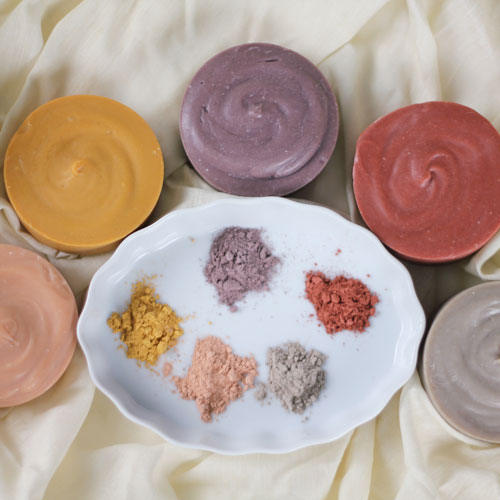 The Brazilian Clay Sampler pack is a great way to try out a variety of clays!
The Brazilian Clay Sampler pack is a great way to try out a variety of clays!
In cold process soap, clays are a fantastic natural colorant option. In the Waves of the Sea Cold Process, sea clay adds a smoky green layer that looks great against the deep blue. Dark red Brazilian clay is used in both the Honey Bee Cold Process and the Natural Colorant Taiwan Swirl, resulting in various shades of pink.
Dark red Brazilian clay also works wonderfully in hot process, as shown in the Oven Process Layers Tutorial. Many soapers choose to disperse clays in water rather than oil in cold process soap. Clay naturally absorbs liquid, and dispersing them in water prevents the clay from drying out the soap which may lead to a crumbly bar.
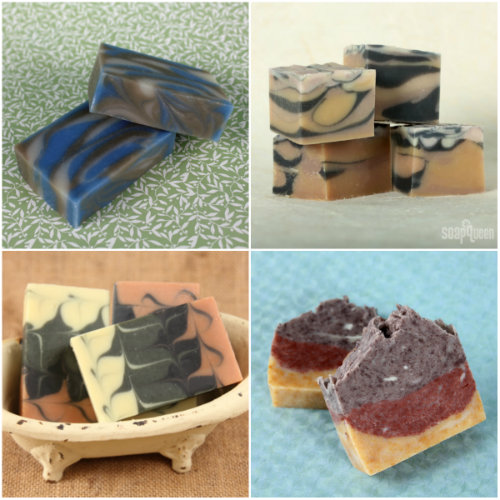 Top row, left to right: Waves of the Sea Cold Process, Honey Bee Cold Process
Top row, left to right: Waves of the Sea Cold Process, Honey Bee Cold Process
Bottom row, left to right: Natural Colorant Taiwan Swirl, Oven Process Layers
If you prefer to make melt and pour soap, clays work wonderfully. In the Under Your Spell Melt and Pour Clay Tutorial, various Brazilian clays are used to fill in the intricate details of the Paisley Tray Mold. If you’d like to learn more about Brazilian clay, check out the Sunday Night Spotlight: Brazilian Clay post. The oil absorbing properties of green zeolite clay is used in the Tea Tree & Rosemary Cleansing Bar to create a facial soap for oily skin types.
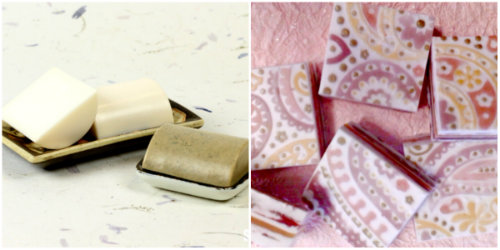 Left to right: Cleansing Bars for Dry and Oily Skin, Under Your Spell Melt and Pour Clay Tutorial
Left to right: Cleansing Bars for Dry and Oily Skin, Under Your Spell Melt and Pour Clay Tutorial
If you’re looking for even more melt and pour ideas, the Charcoal and Rose Clay Spa Bar on Soap Queen TV uses rose clay to give the project a beautiful pink hue. Activated charcoal adds a striking layer of contrast, and also contributes cleansing properties to the project. This soap is not only striking, the essential oil blend of Red Brazilian Mandarin, Rose Absolute and Sandalwood smells amazing.
Because clays have gentle exfoliation properties, they are the perfect addition to body and facial scrubs. In the Rose Clay Sugar Scrub, rose clay adds color and contributes to the scrubs creamy, thick texture. In the Rough Patches Wash Tutorial, walnut shells and bentonite clay create a body scrub that’s perfect for the knees, elbows, hands and feet. Looking for an extra gentle scrub that also acts as a facial mask? The Oatmeal Facial Scrub & Mask contains oil-absorbing bentonite clay, leaving skin feeling clean and refreshed.
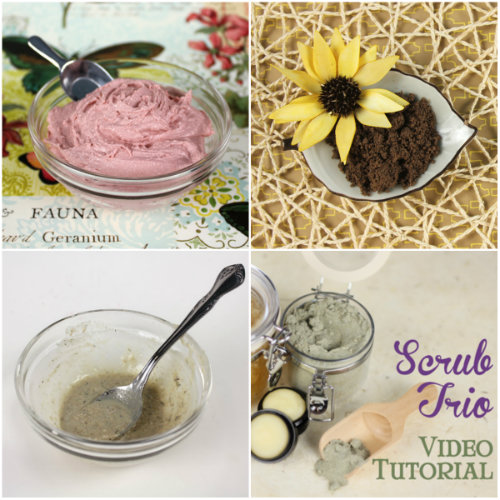 Top row, left to right: Rose Clay Sugar Scrub, Rough Patches Wash
Top row, left to right: Rose Clay Sugar Scrub, Rough Patches Wash
Bottom row, left to right: Oatmeal Facial Scrub & Mask, 3 Scrub Recipes on Soap Queen TV
When used in bath bombs, clays create a harder bath fizzy. In particular, kaolin clay is a fantastic choice for bath bombs because of its neutral color. In the French Macaron Inspired Bath Fizzies, kaolin clay helps the thin bath fizzy shape stay together. Kaolin clay is also used in the For the Love of Waterlily Bath Bomb, a project that’s full of color and perfect for Valentine’s Day. If you’re looking for more colorful, heart-inspired bath bombs, the Mini Heart Bath Bombs contain pink Brazilian clay for a soft hint of color.
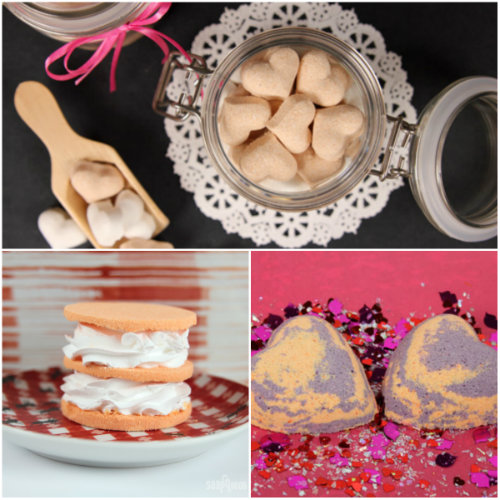 One of the most popular uses of clays in the beauty industry is to create facial masks. In the Cleansing Clay Mask episode of Soap Queen Tv, three facial masks are created using various ingredients designed for different skin types. If your skin is on the oily side, clays can be mixed with water immediately before application to create an oil absorbing paste. If your skin needs more hydration, mixing the clays with oil creates a moisturizing clay mask. Learn how to make both types, along with a “Fresh Clay Mask” in the Soap Queen TV episode below.
One of the most popular uses of clays in the beauty industry is to create facial masks. In the Cleansing Clay Mask episode of Soap Queen Tv, three facial masks are created using various ingredients designed for different skin types. If your skin is on the oily side, clays can be mixed with water immediately before application to create an oil absorbing paste. If your skin needs more hydration, mixing the clays with oil creates a moisturizing clay mask. Learn how to make both types, along with a “Fresh Clay Mask” in the Soap Queen TV episode below.
What is your favorite way to use clays in your projects? Keep your eyes on the blog in the coming week for a collection of recipes using a wide varieties clays!
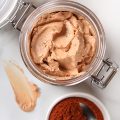
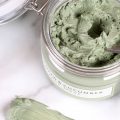
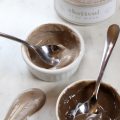
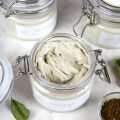
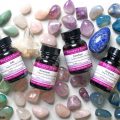
Hi!
I have just recently discoveres Australian black clay, but I can’t find much information about using it in soap. Do you have any experience with black clay in CP soap, is it safe to use?
Thank you in advance!
Maria
Hi Maria!
We haven’t done any testing with Australian black clay, so I’m not entirely sure! Before using it, I would definitely recommend checking with the manufacturer to see if it’s skin safe. If so, you can use it like other clays, which involves mixing 1 teaspoon of the clay into 1 tablespoon of water. That helps it distribute nicely and prevents clumping. 🙂
We used French green clay in our Avocado + Spearmint Cold Process Tutorial with great results: https://www.soapqueen.com/bath-and-body-tutorials/avocado-spearmint-cold-process-soap-tutorial/
-Kelsey with Bramble Berry
Hi not sure if this helps but I’m from Australia and although I love our clays I found the Australian black clay very heavy and on the gritty side. I think activated charcoal is much better personally. Happy soaping!
The girl from OZ hehe
Nicki
Thank you Nicki, that’s super helpful! Activated charcoal is a great option for coloring soap. 🙂
Activated charcoal: https://www.brambleberry.com/Activated-Charcoal-P4956.aspx
-Kelsey with Bramble Berry
HI,
If I wanted to add French yellow clay to my soap recipe, can I add it to the water and lye mixture?
Thanks
Hi AJ!
We typically mix the clay with distilled water and add it at trace. I think adding it to the lye mixture would work though! I would definitely recommend a small test batch first. Clays absorb moisture, so they can accelerate trace. We like to add them at trace so we have a bit more time to work. 🙂
Read more about working with clays in this post: https://www.soapqueen.com/bramble-berry-news/sunday-night-spotlight-brazilian-clay/
-Kelsey with Bramble Berry
If I wanted to portion off 1 cup of the (CP) soap batter to color with a clay, how much clay would you recommend I premix before adding the soap batter? Would I premix this with water?
Thank you.
Hi Gina!
For a cup of soap, I would recommend mixing 1 teaspoon of clay with 1 tablespoon of distilled water. Then, you can add that clay 1 dispersed tablespoon at a time until you get a color you like. 🙂
Learn more about using clay in cold process soap in this Sunday Night Spotlight: http://www.soapqueen.com/bramble-berry-news/sunday-night-spotlight-brazilian-clay/
-Kelsey with Bramble Berry
I was wondering if you could make clay masks (any recipe) and have the liquid already added to it when you sell it. It seems like it would be more professional that way. So I was wondering if I do that and add a preservative if that would work. If so which preservative would be best? Another question I have is about adding fruit and vegetable juices and purees to soap. How do you keep it from molding? I have been on a lot of soap forums and it seems like some soap makers have lots of mold problems and other don’t. What is the difference? Is it the amount they add or the technique or something else? I really want to try this but I don’t want to have it mold a couple of months down the road. Another thing that a lot of soap makers on these forums advise is making soap for several years before you sell it just to make sure your recipes will work. But if we are using recipes from the soap queen do you think we should still wait several years to see how the soap performs before selling it or do you think it would be ok to practice until you get consistent results every time?
Hi Jessica!
You can definitely add a preservative if you want! We typically add preservatives to masks and scrubs. Although they don’t have water in them, they will likely get water splashed into them during use. Optiphen would work well! You can use that at 1% in your recipe. The Talk It Out Tuesday: Preservatives post has more information on that: http://www.soapqueen.com/bath-and-body-tutorials/lotion/talk-it-out-tuesday-preservatives/
You may also like this Rose Clay Mask and Scrub, which is mixed in oil: http://www.soapqueen.com/bath-and-body-tutorials/rose-clay-exfoliating-mask-soap-queen-tv/
Fruit purees are a natural product. That means they will eventually turn brown and go bad. While preservatives protect against mold, they can’t extend the shelf life of the fruit puree. So, you can definitely add them to your products, just keep that in mind. 🙂
Also, you can sell your soap whenever you like! It all depends on what you’re comfortable with. Our recipes have been tested thoroughly, so you can definitely use them. However, there are a lot of variables in soaping, so having a couple recipes under your belt can help you feel more comfortable. I would recommend trying some recipes and see how you feel. This 5 Tips to take Soaping from Hobby to Business post may be helpful for you as well: http://www.soapqueen.com/business/5-tips-take-soaping-hobby-business-slideshare-presentation/
-Kelsey with Bramble Berry
Well I found a recipe using cocoa powder, clay, colloidal oatmeal, and yogurt powder. Then you combine it with any of the following liquids-water, honey, non face clogging oil or milk. I wanted to mix it up and send it to customers in sealed packets or little jars for samples. But I want it to be already mixed instead of them having to add the liquid when they get it. Obviously milk won’t work. I am hesitant to use oil in a facial application like that. It seems like it would just make your skin oily and not feel clean. So I was thinking water or honey. So if I mix it up and add the preservative will it be good until the shortest expiration date of one of the products?
So the saponification process doesn’t change the fruit/vegetable juice/puree in some way that extends its life? Since you have to let soap cure fore 4 to 6 weeks, wouldn’t it me moldy by the time you could use it? I guess that is what I don’t understand. I see soap makers with this kind of soap, and it has been cured the whole time, but they obviously aren’t selling moldy soap. So how are they keeping it from molding? Thanks!
Hi Jessica!
If you send those masks mixed with water, they will have a shorter shelf life – probably about 6 weeks or so. That is because the water rehydrates the yogurt. You can tell your customers to keep the mask in the fridge, as that will prolong that shelf life. 🙂
I’m actually not sure what honey would do! Honey has a longer shelf life, but I’m not sure if that yogurt will rehydrate. I would recommend making a small test batch to see.
Also, the saponification does change the fruit puree! It changes it into soap, extending the shelf life to that of the soap. Also, soap has a pH level that doesn’t allow mold to grow. However, the fruit or vegetable puree can eventually turn brown, even though the shelf life is longer. Read more in the Strawberries and Cream Soap Tutorial: http://www.soapqueen.com/bath-and-body-tutorials/cold-process-soap/strawberries-cream-soap-a-cold-process-tutorial/
-Kelsey with Bramble Berry
Thanks Kelsey! So if I sent those masks with oil instead of water or honey, how long do you think the shelf life would be? Is the yogurt powder going to be a problem no matter what kind of liquid I add?
Thanks!
Jessica
You’re welcome! With oil, I think those masks will definitely last a little longer. The yogurt powder may still have a shorter shelf life. I think the best way to tell is to test a mask with each liquid and see how they do. 🙂
-Kelsey with Bramble Berry
Love making soap
Hi Patricia!
Me too! It’s so much fun to make. 🙂
-Kelsey with Bramble Berry